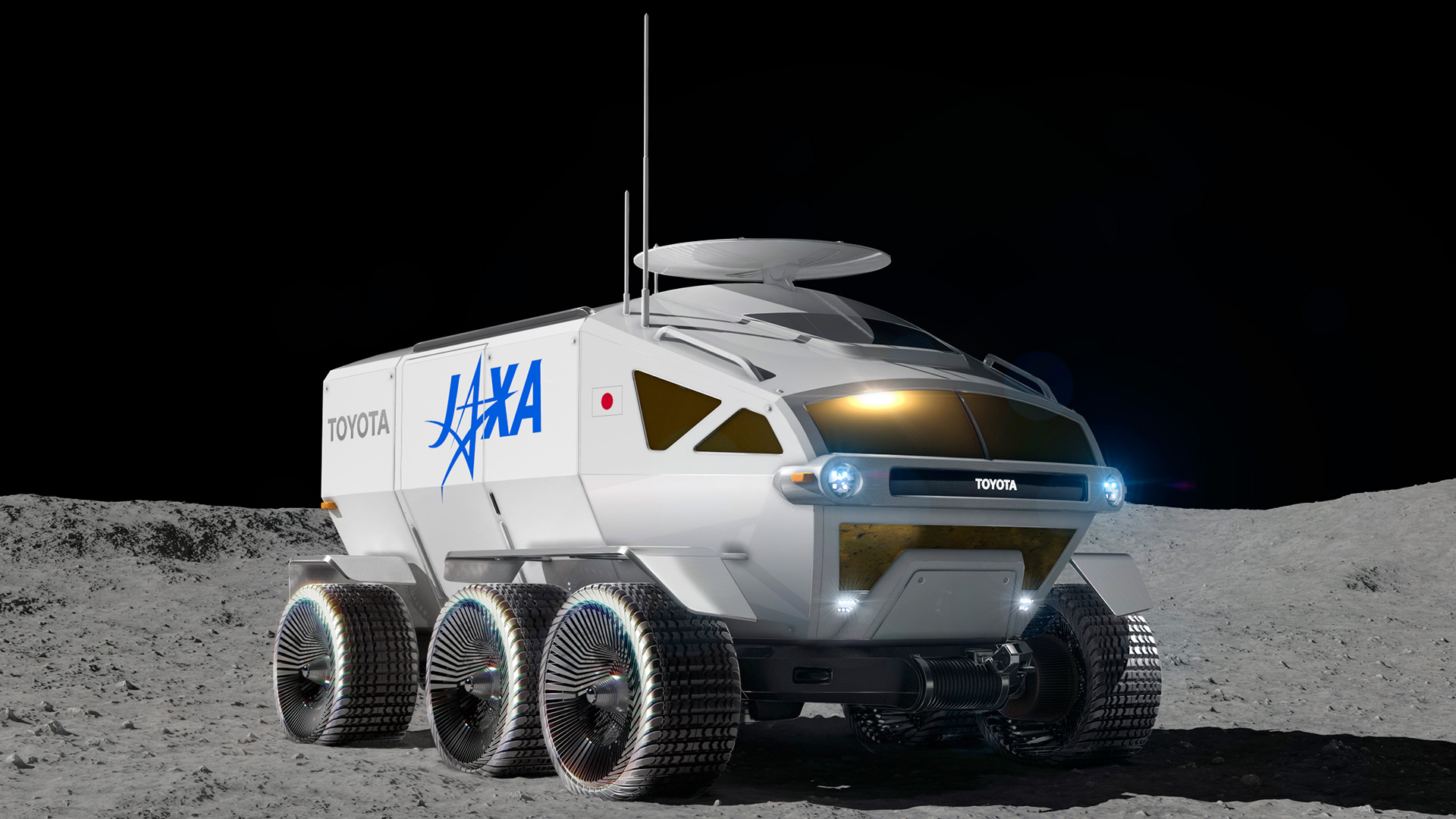
We now know what to call the crewed lunar rover being developed by the Japan Aerospace Exploration Agency (JAXA) and Toyota.
The pressurized moon vehicle, which is expected to launch in the late 2020s, has been nicknamed "Lunar Cruiser," JAXA and Toyota representatives announced in an update last week.
The moniker, a nod to Toyota's Land Cruiser SUV, "was chosen because of the familiar feeling it offers the people involved in the development and manufacture of the vehicle prototype as part of the joint research project as well as the familiarity it will provide the general public," the update reads.
Related: Living on the moon: What it would be like (infographic)
JAXA and Toyota signed an agreement last summer to develop the lunar rover, which will incorporate fuel-cell electric-vehicle technologies. This year, the partnership is working to build test parts for each major piece of the vehicle, and for a prototype of Lunar Cruiser itself.
"The work involves the use of simulations to confirm power and heat dissipation performance while driving, the manufacture and assessment of prototype tires, and the use of virtual reality and full-scale models to consider the layout of equipment in the cabin of the Lunar Cruiser," the update states.
JAXA, Toyota and Mitsubishi Heavy Industries lead the Team Japan Working Group, which was established in August 2019 to study ways to help create a sustainable human presence on the moon. Making this ambitious goal a reality will almost certainly require international cooperation — with NASA, for example, which is working toward the same aim with its Artemis program.
Breaking space news, the latest updates on rocket launches, skywatching events and more!
The Lunar Cruiser could play an integral role in the expansion of human society to the moon. For example, the vehicle could help astronauts explore the lunar polar regions for water ice and other resources, Toyota representatives said last year when announcing the rover project.
Lunar Cruiser wouldn't be the first crewed rover to roam the moon's gray hills. NASA launched astronaut-driven "moon buggies" on the final three Apollo missions, in 1971 and 1972. Unlike Lunar Cruiser, however, the Apollo rovers were unpressurized, so the astronauts who rode in them had to wear spacesuits.
Mike Wall is the author of "Out There" (Grand Central Publishing, 2018; illustrated by Karl Tate), a book about the search for alien life. Follow him on Twitter @michaeldwall. Follow us on Twitter @Spacedotcom or Facebook.
Join our Space Forums to keep talking space on the latest missions, night sky and more! And if you have a news tip, correction or comment, let us know at: community@space.com.

Michael Wall is a Senior Space Writer with Space.com and joined the team in 2010. He primarily covers exoplanets, spaceflight and military space, but has been known to dabble in the space art beat. His book about the search for alien life, "Out There," was published on Nov. 13, 2018. Before becoming a science writer, Michael worked as a herpetologist and wildlife biologist. He has a Ph.D. in evolutionary biology from the University of Sydney, Australia, a bachelor's degree from the University of Arizona, and a graduate certificate in science writing from the University of California, Santa Cruz. To find out what his latest project is, you can follow Michael on Twitter.
-
newtons_laws That could be a useful vehicle to have for manned lunar exploration, and it's interesting to see that Toyota is part of the Japanese partnership designing this, as Toyota has several years experience in developing the Mirai hydrogen fuel cell powered vehicle. The Apollo lunar rovers of course just used one time use non-rechargeable (silver-oxide) batteries. However for a lunar vehicle that is meant to be re-used it makes a lot of sense to use hydrogen and oxygen fuel cells since the hydrogen and oxygen required can be produced on the lunar surface from the water ice that is known to exist in the Moon's polar regions.Reply -
motie Thank heavens it's pointy in front. The air drag at 2 miles per hour in a vacuuum must be tremendous.Reply -
egribble Reply
Will it have the ability to dock? The Dynetics lander has a low slung configeration in part so rovers can dock. Also a habitat module on the descent Blue Origin may also be able to be configured so a rover can dock. Why suit up and depressurize (risking lunar dust contamination) if docking is possible?Admin said:The crewed lunar rover being developed by the Japan Aerospace Exploration Agency and Toyota now has a (nick)name.
Meet 'Lunar Cruiser': Japan's big moon rover for astronauts gets a nickname : Read more -
newtons_laws Reply
Good point, but that would require collaboration between the different nations/companies to ensure compatible docking mechanisms. In an ideal situation that would take place, but I think at the moment the individual lunar exploration designs aren't internationally co-ordinated. :(egribble said:Will it have the ability to dock? The Dynetics lander has a low slung configeration in part so rovers can dock. Also a habitat module on the descent Blue Origin may also be able to be configured so a rover can dock. Why suit up and depressurize (risking lunar dust contamination) if docking is possible? -
Mergatroid Replyegribble said:Will it have the ability to dock? The Dynetics lander has a low slung configeration in part so rovers can dock. Also a habitat module on the descent Blue Origin may also be able to be configured so a rover can dock. Why suit up and depressurize (risking lunar dust contamination) if docking is possible?
I don't see why they would design it without docking in mind. In any case, astronauts will have to go outside at times. There was one scifi movie, can't remember which, where they had a spacesuit or two basically docked into the rear of the pressurized rover they were using. They would enter the spacesuit from the inside, then seal and undock the suit.
